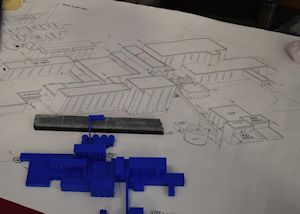Making for Learning: Concrete Connections
Recently there was excitement on the listserve about a Laser Cutter, with a new product announced that was priced around $2500. Back in the last century that was more than my yearly budget for physics lab materials, at a well funded school. Another hot item is vinyl cutters. Although less expensive, it seems that the most popular use is to make badges for micro-credentialing.
These are not bad things to do….
Some questions should be asked when considering allocating limited school resources in for these tools. What is the educational value, the learning return on investment? What standards are being addressed - collaboration? problem solving? artistic design? Are there specific ISTE, NGSS, or NCAS standards met with the learning design? Talking to an advocate, the passion for meeting student standards using the making process is well argued, and watching a Maker Faire the excitement and engagement of students is clearly evident. These are not bad things to do….
But critical questions remain…
Is this the most cost effective way to meet these standards?
Is this the most effective use of the limited amount of student engagement to generate meaningful (deep, persistent, life-long) learning?
Helping students learn involves creating connections to prior knowledge, a basic foundation of constructivism. With more abstract learning, multiple representations allow students to approach the subject from more directions. In physics, we would require students to use multiple ways of describing the same system. For example, the motion of a falling object would be represented with written description, graphically, algebraically, geometrically (strobe photo, vector diagram), and numerically. These multiple representations allowed students to put the learning in context with previous learning in multiple ways -- it was often that they would note that all of a sudden algebra and differentiation had a real-world connection.
The difference is one of intention….
We can intentionally use the excitement and engagement created by making to enhance the cognitive understanding of the physical world (STEM). I saw a great example of this in the 3D Vermont Competition, held annually for students in middle and high school. Students working in school teams use pictures, google maps, geolocation, sketch plans, engineering drawings, and town historical resources, in concert with CAD and 3d modeling tools to create a scale model of a building in their community. The competition involves history, architecture, multimedia and presentation skills. But it is the connection of the mathematical and physical world, sometimes involving databases, spreadsheets, and GIS information, bringing in physical representations and computer tools, that brought meaningful understanding to many of the students in the project, as they would excitedly explain to anyone at the event.
I have also seen examples of making that do not have any apparent additional learning beyond the “wow” factor. These may in fact lead to misconceptions about the underlying physical world. Many of these fall into the realm of electricity. Although copper tape and cardboard can be used to make circuits, and a piezoelectric cell connected to different points on objects can create different pitches, without a conceptual model students will not gain deep learning from the time spent. In the String and Sticky Tape era we had Batteries and Bulbs, and still students graduated from top colleges not knowing how to use a wire, battery, and bulb to make light, much less correctly explain what is happening to the charges and energy with a conceptual model. How is the time spent on these “black box” activities anything more than magic?
The difference between 3D Vermont and 3D printing to make doodads is one of intention. Take advantage of student engagement by intentionally using it to help students develop deeper learning. Their time is too precious for us to to do less.
